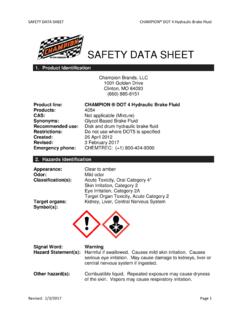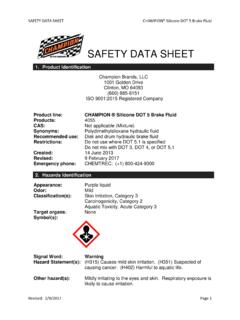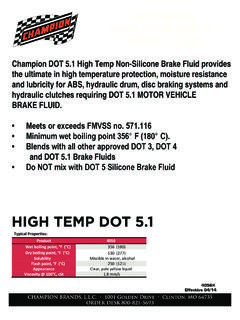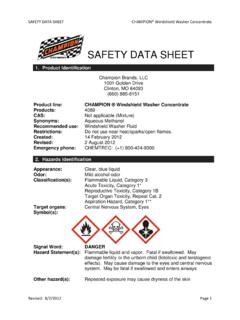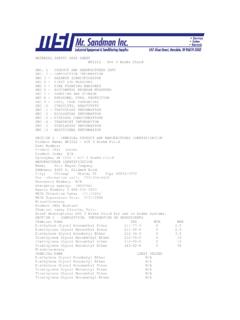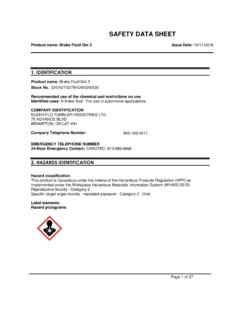Transcription of SAFETY DATA SHEET - Champion Brands
1 SAFETY data SHEET Champion DOT brake fluid Revised: 2/3/2017 Page 1 SAFETY data SHEET 1. Product Identification Champion Brands , LLC 1001 Golden Drive Clinton, MO 64735 (660) 885-8151 Product line: Champion brake fluid Products: 4056 CAS: Not applicable (Mixture) Synonyms: Glycol-Based brake fluid Recommended use: Disk and drum hydraulic brake fluid Restrictions: Do not use where DOT5 is specified Created: 26 April 2012 Revised: 3 February 2017 Emergency phone: CHEMTREC: (+1) 800-424-9300 2. Hazards Identification Appearance: Clear to amber Odor: Mild sweet odor Classification(s): Reproductive toxicity Category 2 Target organs: None known Symbol(s): Signal Word: Warning Hazard Statement(s): Suspected of damaging fertility or the unborn child.
2 Other hazard(s): Combustible liquid. Repeated exposure may cause dryness of the skin. Vapors may cause respiratory irritation. Precaution(s): Wear eye and skin protection before handling. Do not breathe mist/vapors/spray. Use in a well ventilated area. Wear protective gloves/protective clothing. IF IN EYES: Flush with water for 15 minutes and consult a physician. Do SAFETY data SHEET Champion DOT brake fluid Revised: 2/3/2017 Page 2 no ingest. IF SWALLOWED: Do NOT induce vomiting. Immediately call a POISON CENTER or doctor/physician. Disposal: Keep out of waterways. Check local, national, and international regulations for proper disposal HMIS (estimated): Health 1 Fire 1 Instability 0 *Classified based on human experience and epistemological data , not based on strict application of the GHS criteria 3.
3 Composition/Information on Ingredients Hazardous Ingredients: Component CAS No. Conc (wt%) Triethylene glycol monomethyl ether borate ester 30989-05-0 40 70 Triethylene glycol monomethyl ether 112-35-6 15 50 Tetraethylene glycol monomethyl ether 23783-42-8 < 5 Diethylene glycol monomethyl ether 111-77-3 < 1 Monoethanolamine 141-43-5 < 1 2,6-di-tert-butyl-p-cresol (BHT) 128-37-0 < 1 4. First Aid Measures Eyes Remove contact lenses, if worn. Rinse with running water for at least 15 minutes, lifting upper and lower eyelids occasionally. Seek medical attention. Skin Remove affected clothing and launder before reuse. Wash affected area for at least 15 minutes with soap and running water.
4 Prolonged or repeated exposure may cause defatting of the skin symptoms include redness, dryness, cracking Inhalation Remove exposed person to fresh air immediately. Restore or assist breathing, if necessary. Get medical attention immediately if symptoms of CNS depression or intoxication develop Ingestion Do NOT induce vomiting. If conscious, give two full glasses of water. If a significant volume has been swallowed, get medical attention immediately. Additional Info Not determined Specific Treatments Not determined. Treat symptomatically SAFETY data SHEET Champion DOT brake fluid Revised: 2/3/2017 Page 3 5. Fire Fighting Measures NFPA (estimated): Health 3 Fire 1 Instability 0 Flash Point > 115 C / 239 F (calculated) Extinguishing Media For small fires use alcohol foam, dry chemical or CO2.
5 For large fires apply large (flooding) quantities of water from as far away as possible in a spray or mist. Unsuitable Media Water jet may be ineffective Firefighting Procedures: Wear a self-container breathing apparatus if necessary based on concentrations of smoke. Material will produce primarily oxides of carbon as combustion products. Unusual Hazards Not Determined 6. Accidental Release Measures Personal precautions, protective equipment, and emergency procedures: Ventilate if released in a confined area. Avoid breathing mists/vapors/spray. Product may present slipping hazard if left on the floor. Beware of vapors pooling in low areas to explosive concentrations.
6 Environmental precautions: Avoid release to the environment. Prevent from entering into soil, ditches, sewers, waterways or groundwater Methods for removal: Use an pump to remove bulk liquid. Residual liquid can be absorbed on inert material. Dispose of contaminated adsorbent as hazardous waste. Wash the area with water after excess product and adsorbent is removed. 7. Handling and Storage Max. Handling Temp: Not determined Procedures: Use in a well ventilated area. Avoid breathing mists/vapors/spray. Avoid handling hot product where possible. Use appropriate personal protective equipment to avoid contact with skin and eyes. Note the location of nearest emergency shower and eye wash station before use.
7 Store with the lid tightly closed in a cool, dry, well-ventilated SAFETY data SHEET Champion DOT brake fluid Revised: 2/3/2017 Page 4 place. Product is hygroscopic and effectiveness may diminish if opened product is stored for long periods of time. Dispose of spilled or used material in accordance with local, regional, national, and international regulations. Max Store Temp: Do not store or handle at elevated temperatures. 8. Exposure Controls/Personal Protection Exposure Limits US Guidelines by component Triethylene glycol monomethyl ether borate ester ACGIH TWA: 2 mg/m3 ACGIH TWA: 6 mg/m3 Monoethanolamine ACGIH TWA 3 ppm ACGIH STEL 6 ppm OSHA PEL 6 mg/m3; 3 ppm Other Exposure Limits: Not determined Engineering Controls: Use in a well ventilated area.
8 Local and general ventilation should keep methanol vapor concentration below permissible limits. Where exposure potential exceeds recommended limits, use a NIOSH/OSHA approved supplied air respirator as recommended. Vapors are heavier than air and will tend to accumulate in low-lying areas. Personal Protective Equipment Respiratory: Use a NIOSH or CEN approved full-face respirator with multi-purpose combination or type ABEK respirator cartridges as a backup to engineering controls. If the respiratory is the only means of protection, use a full-face supplied air respirator Eye: Use tightly-fitting chemical splash goggles. Use face shield, especially where splashing is likely to occur Gloves: Use nitrile, butyl, viton, or fluoroelastemer gloves.
9 Even appropriate materials may degrade after prolonged exposure with product. Clothing: Use chemical resistant pants and jackets, preferably of butyl or nitrile rubber SAFETY data SHEET Champion DOT brake fluid Revised: 2/3/2017 Page 5 Other: Locate the nearest eyewash station and SAFETY shower before handling this product. Limit exposure whenever possible. Hygiene: Wash thoroughly after handling this product. 9. Physical and Chemical Properties Appearance Clear, pale yellow liquid Odor Mild, sweet odor Odor threshold Not determined pH Melting Point < -50 C / -58 F Initial Boiling Pt > 265 C / 509 F Flash Point 115 C / 239 F Evaporation Rate Not determined Upper Flammable Lm Not determined Lower Flammable Lm Not determined Explosive data Vapors may form explosive mixtures with air Vapor Pressure hPa ( mmHg) @ 20 (68 F) Vapor Density > 5 (Air = 1) Volatile Organics Not determined Density mg/cu.
10 Cm C Solubility Miscible in water, alcohol; sparingly soluble in some organic solvents Kow Not determined Viscosity mm/s2 @ 100 C Autoignition Point 310 C / 590 F Decomposition Temp Not determined 10. Stability and Reactivity Stability Material is normally stable at ambient temperatures and pressures. Decomposition Temp Not determined Incompatibility Keep away from strong oxidizers and strong acids/bases. Keep away from strong reducing agents such as powdered active metals Polymerization Will not occur Thermal Decomposition Primarily oxidizes to carbon dioxide in normal combustion conditions. In lower oxygen environments carbon monoxide, formaldehyde, or formic acid may be formed.

